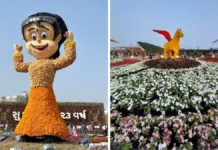Can films be agents of social change?
 Since the first Indian silent film, Raja Harishchandra directed by Dada Saheb Phalke in 1913 and the first talkie movie Alam Ara made in 1931 which had a four-minute kissing scene (it would give Imran Hashmi an inferiority complex) up to the adorable deaf & dumb Barfi (already India’s official entry for Oscar), the Indian film Industry has come of age.
Since the first Indian silent film, Raja Harishchandra directed by Dada Saheb Phalke in 1913 and the first talkie movie Alam Ara made in 1931 which had a four-minute kissing scene (it would give Imran Hashmi an inferiority complex) up to the adorable deaf & dumb Barfi (already India’s official entry for Oscar), the Indian film Industry has come of age.
With an annual turnover worth US$ 3 billion, offering direct and indirect employment to over 6 million people and churning over 800 films each year in half a dozen languages, Indian film industry is one of the largest in the world. In 2002 around, 1.3 billion cinema tickets were sold in India; on, an average, 43 millions film buffs flock cinema halls across the country every day.
Nowhere else do film actors exercise such a hold on the national psyche. College and University students and the youth in general try to emulate their favorite heroes and heroines in their dresses, hair style, mannerism and body language. Manufacturers sign up reigning film stars for endorsement of their brands. Amitabh Bachchan, the Khans – Aamir, Salman, Shahrukh and Saif – Akshaya, Hrithik, Ranbir, Katrina, Kareena, Deepika, Anushka and Sonakshi are ruling the roost. Fading actors endorse Shaktibhog atta, Annapoorna biscuits, Lux cosy underwear etc! Political parties woo actors, tired and retired, to attract audiences, add a dose of glamour and get votes; especially in a hotly contested election.
But doesn’t this technology driven reach and enormous influence on account of larger than life filmy persona also put some moral responsibility on the shoulders of film artists?
At the dawn of Independence, film makers made films that raised social issues of their time. Chetan Anand’s Neecha Nagar of (Grand Prix Cannes 1946) and Bimal Rai’s Do Bigha Zamin (winner at Cannes & Karlovy 1953) were pioneers in this trend. Satyajit Ray’s trilogy, Raj Kapoor’s Awara, Shri 420 and Jagte Raho and Guru Dutt’s Pyasa, Kagaz Ke Phool and Sahib Bibi Aur Ghulam were examples of neo-realist cinema – believable, authentic & contemporary. They stressed Nehruvian idealism and raised social issues; many relevant even today.
Mother India was a timeless classic on rural India (first Indian film to be nominated for an Oscar) whose soul searching dilemma between one’s duty and personal relationship has influenced films like Ganga Jamuna, Deewar and Shakti.
K Asif’s magnum opus Mughal e Azem wasn’t just a royal drama of a prince’s affairs with a nautch girl but a sharp edged clash of values, human relationships and a ruler’s duty epitomized in its memorable dialogues. Presenting opulence of an era gone by, heart wrenching story and haunting music as in Pakeezah and Umrao Jaan touch upon customs, traditions and social norms of a decaying era.
Sadhna and Mausam raised the issue of prostitution; Dhool ka Phool of surrogate mother, Ganga Jamuna, Jis Desh Mein Ganga Bahti Hai and Mujhe Jeene Do of poverty, exploitation and dacoits and their rehabilitation. With different stories/treatment, Sant Gyaneshwar, Dosti, Sarda, Naya Daur, Char Dil Char Rahein, Phir Subah Hogi, Bandini, Sujata, Hum Dono, Parakh and Kanoon underlined morals, ethics, social values and one’s call of conscience. Sholay, a mega hit, covers them all.
Sharat Babu’s Devdas (remade so many times) is not only an endearing love story but also a commentary on the Bengali society of its time. Love triangle and extra marital affairs have been eternal favorites of directors and have given high voltage dramas like Andaz, Gumrah, Sangam, Arth and Kabhi Alvida Na Kehna.
Earlier, the hero represented the good and the villain the evil and films ended with triumph of the good over evil. Raj Kapoor, Dilip Kumar, Dev Anand, Dharmendra and Amitabh have portrayed characters, at least once, which had shades of grey. But none tasted success and mass adulation by enacting negative characters as did Shahrukh in films like Darr and Baazigar. He made negative characters menacing but adorable and saleable.
Indian Cinema is not all Bollywood. More films are made in Chennai and Hyderabad than in Mumbai. Ray’s Charulata, Aranyer Din Ratri, Shatranj Ke Khilari, Arvindan’s Chidambaram, Vasthuhara and Uttarayan, Ritwick Ghatak’s Meghe Daka Tara, Komal Gandhar, Subarna Rekha, Mrinal Sen’s Bhuvan Shome, Khandhar and Parashuram and Rath Kaneer, Guna, Iruvar, Mundaram Pirai, Nayakan and Gauravam in Tamil are milestones of Indian cinema. Jeetendra, Anil Kapoor and Salman have thrived on Tamil remakes.
100 crore earners: Ghazni, Wanted, Dabangg, Singham, Rowdy Rathore prove action still sells. Shirtless Salman with his eight packs and bulging muscles has inspired new entrants who show off chiseled physique. However, success of Three Idiots, Zindagi Na Milegi Dobara and Barfi shows that films can touch million hearts without action!
Many viewers feel that films like Haqeeqat, Shaheed, Border and Gadar Ek Prem Kahani promote national fervor and depiction of extreme violence, use of abusive, profane and vulgar language; exposure of flesh and lewd double meaning dialogues/songs in films impact young and impressionable minds negatively. But who should judge?
Unkind, ruthless, selfish, greedy, corrupt and exploitative society has been exposed in films of Mehboob Khan, Raj Kapoor and Guru Dutt. Shyam Benegal’s films Ankur, Manthan, Bhumika, Mandi and others like Sardari Begam, Maqbool, Well Done Abba have strong social content.
Films like Aakrosh, Chakra, Paar, Ardh Satya, Garam Hawa, Bavandar raise inconvenient questions. Prakash Jha’s films Damul, Ganga Jal, Mritudand, Apharan, Rajneeti and Aarakshan dissect society with all its ugliness. Films like Ghayal, Satya, Shool, Chandni Bar, Page 3, Once Upon A Time in Bombay unfold the seamy underbelly of mega cities.
Middle of the path, where the Commercial and Art Cinema merge are best represented by Hrishikesh Mukherjee (Anand, Satyakaam & Chupke Chupke); Basu Chatterjee (Rajanigandha) & Basu Bhattacharya (Teesri Kasam); Gulzar (Parichay, Koshish, Namkeen). They gave meaningful and socially relevant and entertaining films.
Raj Kapoor used to say there are only two kinds of films; good films and bad films. The thin line dividing the Art Cinema and Commercial cinema is blurring; Amitabh does Blue and Paa and Vidya Balan doesn’t mind doing a Dirty Picture and Ranbir Kapoor is game for new characters. Shahrukh who became Badshah Khan with films like Dil to Pagal Hai, Kuchh Kuchh Hota Hai, Dil Wale Dulhania Le Jayenge does Swadesh, Chak De India and My Name is Khan. Aamir will always be remembered for his Lagaan, Rang De Basanti, Tare Zamin Per. Yet, Salman with success of Dabangg, Ready, Bodyguard and Ek Tha Tiger, collecting crores without a message, romancing heroines half his age, rules the Box Office!
Can films be a catalyst for action to fight the evils of our society? We see films, they get talked about; some even get rave reviews and awards and are then forgotten. They don’t spur social change. But who is to blame? Hasn’t the society become insensitive, corrupt and callous beyond redemption?
Films like Wednesday, Iqbal, MMS Ragini, Vicky Donor, Kahani, Paan Singh Tomar, Gangs of Wasseypur show real slices of lives but can’t match 100 crore grossers which offer action, Jhandu Balm and Sheila ki Jawani.
Even if films can’t be agents of change, they can serve the society constructively by drawing attention, instigating discussion and debate and hopefully encouraging viewers to initiate action – not a mean achievement by any standard.
Surendra Kumar, a former diplomat, is an avid film buff.
Surendra Kumar






